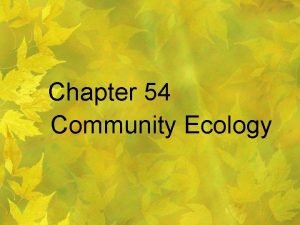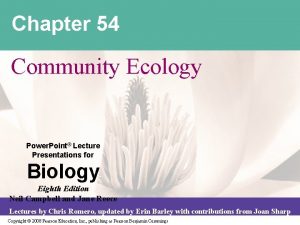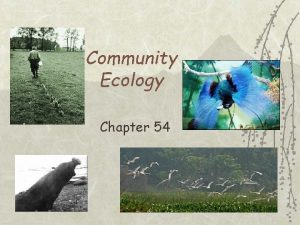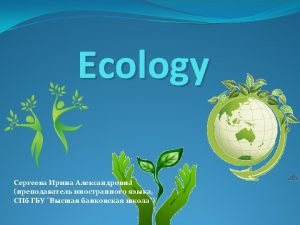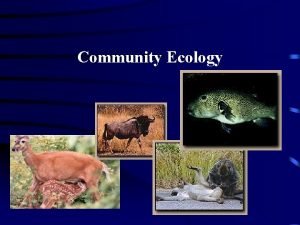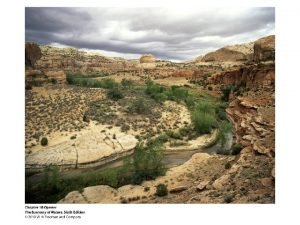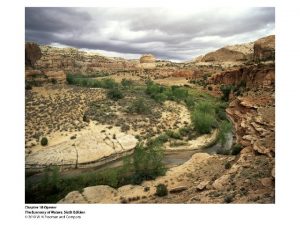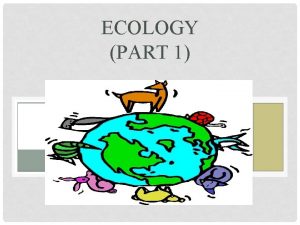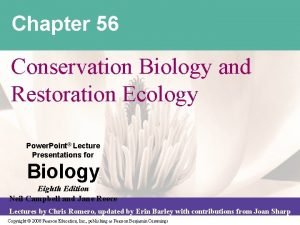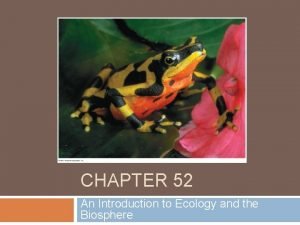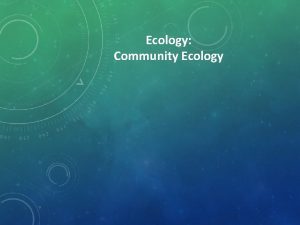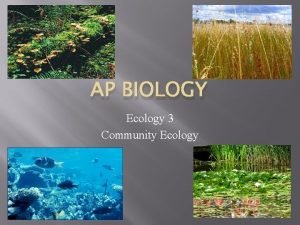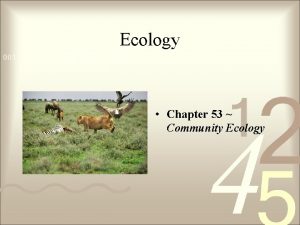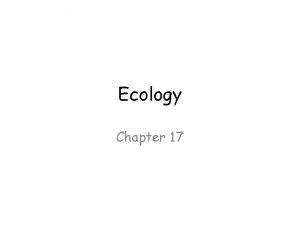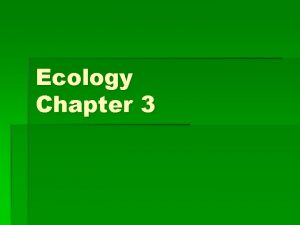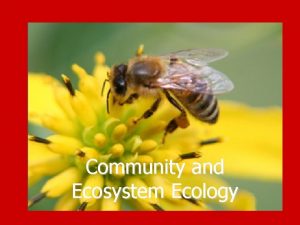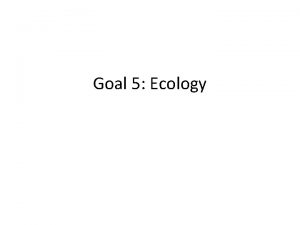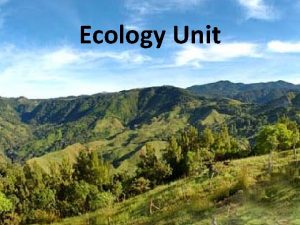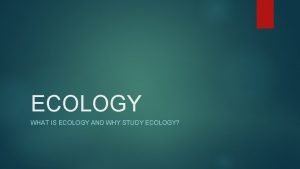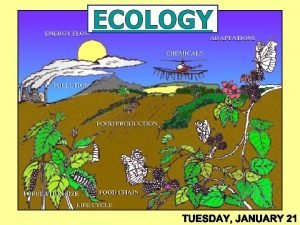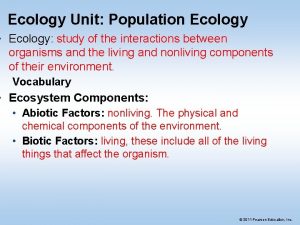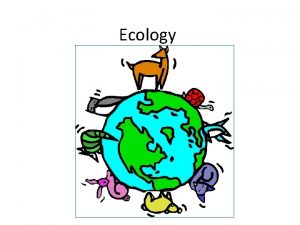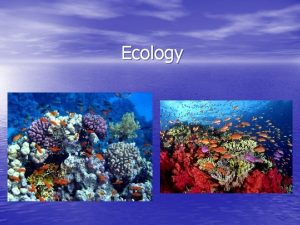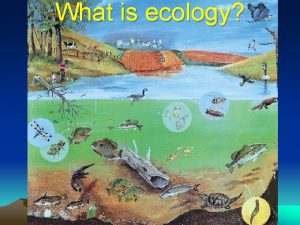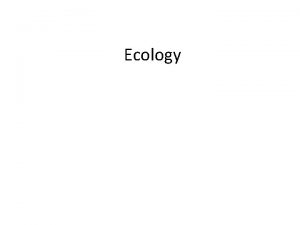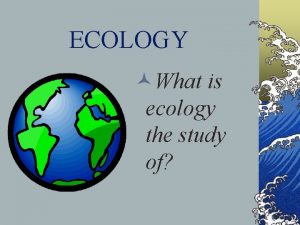Chapter 54 Community Ecology Community Ecology The study
















































































- Slides: 80

Chapter 54 Community Ecology

Community Ecology • The study of the interactions between the species in an area.

Interspecific Interactions • Interaction between species. • May be positive, negative, or neutral. • Ex: 1. Coevolution 2. Predation 3. Mimicry 4. Competition 5. Symbiosis

Coevolution • When two species have reciprocal evolution to each other. • Ex: • Flowers and their pollinators.

Predation (+/-) • Predator and prey relationships. • Ex – Lynx and Hares

Herbivory (+/-) • When an organism eats parts of a plant or algae. • Herbivore – may have special adaptations to find their prey. • Plants – may have adaptations to avoid being eaten.

Predation/Herbivory • Often results in interesting defenses or adaptations. • Ex: • Cryptic coloration • Aposematic coloration

Cryptic Coloration • A passive defense where the prey is camouflaged against its environment.

Aposematic Coloration • The use of conspicuous colors in toxic or unpalatable organisms to warn off predators. poison arrow frogs

Mimicry • Defense mechanism where the mimic has a resemblance to another species, the model. • Types: • Batesian • Müllerian

Batesian Mimicry • Palatable species mimics an unpalatable model. Hawk moth larva Snake

Müllerian Mimicry • Two unpalatable species resemble each other. Cuckoo Bee Yellow Jacket

Competition • When two species rely on the same limiting resource. • Intraspecific competition usually more severe than Interspecific competition. • Why?

Competitive Exclusion Principle • Predicts that two species with the same requirement can not co-exist in the same community. • One species will survive and the second will go extinct.

Ecological Niche • The n-hyperspace of requirements for a species. • How a species “fits into” an ecosystem. • Species can not have niche overlap, the Competitive Exclusion Principle

Niche Types 1. Fundamental - what a species is theoretically capable of using. 2. Realized - what a species can actually use.


Resource Partitioning • A way that species avoid niche overlap by splitting up the available resources. • Ex: Anolis lizards

A. distichus A. insolitus


Symbiosis • When two different species live together in direct contact. • Types: 1. Parasitism 2. Commensalism 3. Mutualism

Parasitism (+/-) • Parasite harms the host. • Parasites may be external or internal. • Well adapted parasites don't kill the host.


Commensalism (+/o) • One partner benefits while the other is unchanged. • Ex. – Cattle and Egrets

Mutualism (+/+) • Both partners Acacia Tree and Ants benefit from the interaction. • Ex: Pollinators and flowers


Assignments • Read Chapter 54 or 45 in Hillis • Lab – essay practice with animal behavior lab • Chapter 54 – Friday • Productivity Lab report – Mon. • Ts lab report – by final exam

Species with large impacts • Some species have larger impacts on a community structure than others. • Ex: • Dominant Species • Keystone Species • Foundation Species

Dominant Species • A species that is the most abundant or has the highest biomass in a community. • Has a major effect on a community both biotically and abiotically.

Reason for Dominance? • Best Competitor? • Best in avoiding predators and disease? • Invasive species may fit the last explanation.

Example • Chestnuts – used to make up to 40% of the forest. • Lost between 1910 -1950 because of fungus disease. • Major impact on wood and nut industries.

Response • Some tree species increased in abundance to fill the gap. • Mammals and birds did OK. • 7 species of insects went extinct.

Keystone Species • Not a dominant species, but has a major impact in the community structure. • Often a top predator that controls the numbers of other species. • Ex. Sea Otters


Foundation Species • Species that cause physical changes in the environment that affect others. • Ex. Beavers, Bison, Black Rush


Succession • Changes in species composition over time.

Succession Stages • Sere: unstable stage usually replaced by another community. • Climax: stable stage, selfreproducing.

Succession Types 1. Primary 2. Secondary

Primary Succession • Building a community from a lifeless area. • Ex: volcanic islands glaciated areas road cuts

Comment • The first example of primary succession was worked out on the Indiana Dunes. • Stages: • • • Open Beach Grasses Conifers (Junipers and Pines) Oaks Beech-Maple forest (Climax)

Secondary Succession • Where a community has been disturbed and the soil is mostly intact. • Ex: • Cutting down a forest • Blow-outs on the Dunes

Causes of Succession 1. Autogenic Factors 2. Allogenic Factors

Autogenic Factors • Changes introduced by the organisms themselves. • Ex: toxins, acids

Allogenic Factors • Outside disturbances • Ex: Fire, Floods

Prairie Succession in Oklahoma - Stages 1. Annual Weeds 2. Triple-Awn Grass 3. Bunch Grass 4. Climax: Tall-grass Prairie

Annual Weed Stage • Lasts 2 -3 years. • Very robust growth (1 -2 m). • Species: Sunflower Pigweed Lamb's Quarter

Annual Weed Stage

Annual Weed Stage

Annual Weed Stage

Triple-Awn Stage • Lasts 10 - 50 years. • Very poor growth (5 -12 cm). • Species: Triple-Awn Grass

Triple Awn Stage

Question • How can Triple-Awn replace the more robust annual weeds?

Allelopathy • The release of chemical inhibitors into the environment. • Sunflower: autotoxic • Triple Awn: tolerant

Triple-Awn • Inhibits Nitrogen fixing bacteria species • Result: soil N stays low which stalls succession.

Bunch Grass Stage • Lasts 20 - 100 years. • Good growth (30 -50 cm). • Species: Little Bluestem

Bunch Grass Stage

Succession Causes • Bunchgrass eventually shades out Triple-Awn, releasing the inhibition of the nitrogen fixers. • Result: soil fertility increases, allowing the next group of species to invade.

Climax Prairie Stage • Lasts centuries if maintained by fire. • High growth (up to 2 meters). • Species: Big Bluestem, Indiana Grass, Switch Grass, Little Bluestem

Tall Grass Prairie

Question • Stages 3 and 4 are the best for cattle grazing. • Normal succession takes 20 -50+ years. • Can the time needed for restoring the prairie be decreased?

Solution • • Add more N to soil (NH 4+) Seed climax species Result: prairie in 3 -10 years. Maintain the prairie by burning.

Upland, IN Prairie

Upland, IN Prairie

Upland, IN Prairie

Point • If you understand the causes and controlling factors of succession, you can manipulate them.

Some points about Succession • The Organisms are changing in the area over time. General pattern is an increase in biodiversity. • The Climate of the area is NOT changing over time.

Other Changes • Soil – becomes richer in N, more depth, better water retention etc. • Light – can decrease at ground level because of shading by taller plants.

Biogeography • Study of the past and present distributions of individual species and communities.

Range Limitations 1. Lack of dispersion. 2. Failure to survive in new areas. 3. Retraction from former range area.

Proof • Fossil Evidence • Pollen Studies • Transplant Experiments

Islands • Special cases in Biogeography. • Must be colonized from other areas.

Island Species Factors • Island size. • Distance from mainland.



Island Size • Small islands hold few species. • Why? • Fewer niches available for species to occupy.

Distance from Mainland • Closer islands have more species. • Why? • Easier for colonization.

Comment • Islands tend to have high numbers of Endemic species • Why? • Adaptive Radiation and Evolution of new species.

Summary • Know the various types of interspecific interactions. • Know the Competitive Exclusion Principle and Niche Concept. • Know Species with large impacts.

Summary • Know some examples and causes of succession. • Know how island communities are shaped.
 Section 1 community ecology
Section 1 community ecology Chapter 54: community ecology answer key
Chapter 54: community ecology answer key Chapter 5 evolution and community ecology
Chapter 5 evolution and community ecology Biological disturbance
Biological disturbance Chapter 5 evolution and community ecology
Chapter 5 evolution and community ecology Chapter 5 evolution and community ecology
Chapter 5 evolution and community ecology Chapter 54 community ecology
Chapter 54 community ecology Chapter 4 population ecology section 1 population dynamics
Chapter 4 population ecology section 1 population dynamics Ecology study guide
Ecology study guide Ecology is the study that helps to preserve
Ecology is the study that helps to preserve Population vs community ecology
Population vs community ecology Population vs community ecology
Population vs community ecology Community ecology
Community ecology Definition of community ecology
Definition of community ecology Community definition ecology
Community definition ecology An organisms rank in a feeding hierarchy
An organisms rank in a feeding hierarchy Ecology part 1
Ecology part 1 Hình ảnh bộ gõ cơ thể búng tay
Hình ảnh bộ gõ cơ thể búng tay Slidetodoc
Slidetodoc Bổ thể
Bổ thể Tỉ lệ cơ thể trẻ em
Tỉ lệ cơ thể trẻ em Voi kéo gỗ như thế nào
Voi kéo gỗ như thế nào Chụp tư thế worms-breton
Chụp tư thế worms-breton Hát lên người ơi
Hát lên người ơi Các môn thể thao bắt đầu bằng từ đua
Các môn thể thao bắt đầu bằng từ đua Thế nào là hệ số cao nhất
Thế nào là hệ số cao nhất Các châu lục và đại dương trên thế giới
Các châu lục và đại dương trên thế giới Công của trọng lực
Công của trọng lực Trời xanh đây là của chúng ta thể thơ
Trời xanh đây là của chúng ta thể thơ Mật thư anh em như thể tay chân
Mật thư anh em như thể tay chân Làm thế nào để 102-1=99
Làm thế nào để 102-1=99 độ dài liên kết
độ dài liên kết Các châu lục và đại dương trên thế giới
Các châu lục và đại dương trên thế giới Thơ thất ngôn tứ tuyệt đường luật
Thơ thất ngôn tứ tuyệt đường luật Quá trình desamine hóa có thể tạo ra
Quá trình desamine hóa có thể tạo ra Một số thể thơ truyền thống
Một số thể thơ truyền thống Cái miệng nó xinh thế chỉ nói điều hay thôi
Cái miệng nó xinh thế chỉ nói điều hay thôi Vẽ hình chiếu vuông góc của vật thể sau
Vẽ hình chiếu vuông góc của vật thể sau Thế nào là sự mỏi cơ
Thế nào là sự mỏi cơ đặc điểm cơ thể của người tối cổ
đặc điểm cơ thể của người tối cổ Giọng cùng tên là
Giọng cùng tên là Vẽ hình chiếu đứng bằng cạnh của vật thể
Vẽ hình chiếu đứng bằng cạnh của vật thể Fecboak
Fecboak Thẻ vin
Thẻ vin đại từ thay thế
đại từ thay thế điện thế nghỉ
điện thế nghỉ Tư thế ngồi viết
Tư thế ngồi viết Diễn thế sinh thái là
Diễn thế sinh thái là Dot
Dot Số nguyên là gì
Số nguyên là gì Tư thế ngồi viết
Tư thế ngồi viết Lời thề hippocrates
Lời thề hippocrates Thiếu nhi thế giới liên hoan
Thiếu nhi thế giới liên hoan ưu thế lai là gì
ưu thế lai là gì Khi nào hổ mẹ dạy hổ con săn mồi
Khi nào hổ mẹ dạy hổ con săn mồi Sự nuôi và dạy con của hươu
Sự nuôi và dạy con của hươu Hệ hô hấp
Hệ hô hấp Từ ngữ thể hiện lòng nhân hậu
Từ ngữ thể hiện lòng nhân hậu Thế nào là mạng điện lắp đặt kiểu nổi
Thế nào là mạng điện lắp đặt kiểu nổi Marine ecology
Marine ecology Chapter 56 conservation biology and restoration ecology
Chapter 56 conservation biology and restoration ecology Chapter 55 ecosystems and restoration ecology
Chapter 55 ecosystems and restoration ecology Chapter 53 population ecology
Chapter 53 population ecology Chaparral climograph
Chaparral climograph Chapter 36 population ecology
Chapter 36 population ecology Section 1 organisms and their relationships
Section 1 organisms and their relationships Chapter 2 principles of ecology answers
Chapter 2 principles of ecology answers Principles of ecology chapter 2
Principles of ecology chapter 2 Ecology
Ecology Chapter 53 population ecology
Chapter 53 population ecology Chapter 55 ecosystems and restoration ecology
Chapter 55 ecosystems and restoration ecology Chapter 4 section 1: population dynamics
Chapter 4 section 1: population dynamics Chapter 2 section 1 organisms and their relationships
Chapter 2 section 1 organisms and their relationships Chapter 4 section 1 population dynamics answer key
Chapter 4 section 1 population dynamics answer key Chapter 53 population ecology
Chapter 53 population ecology Case series
Case series Retrospective cohort study
Retrospective cohort study Process of method study
Process of method study Study less study smart
Study less study smart In area
In area Distinguish between motion study and time study
Distinguish between motion study and time study

